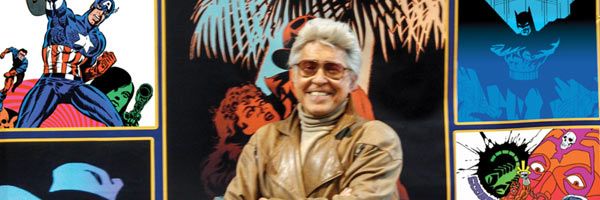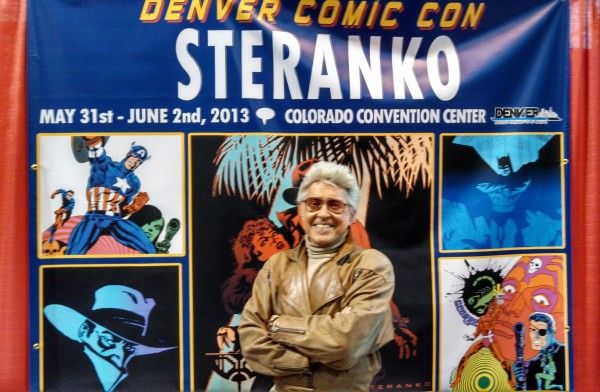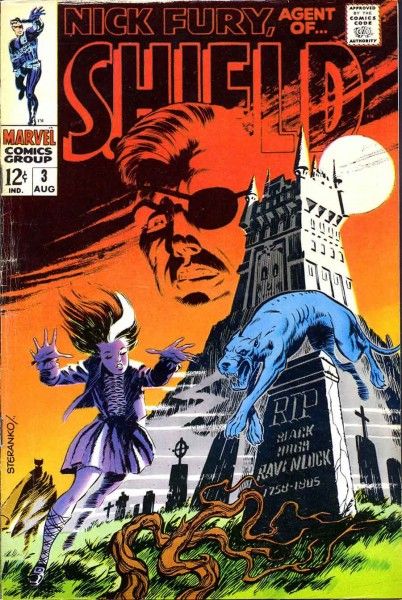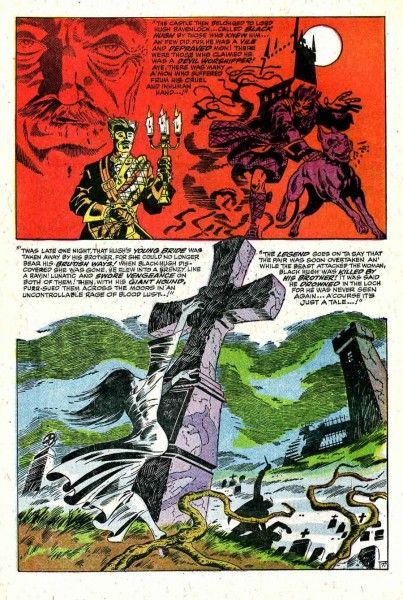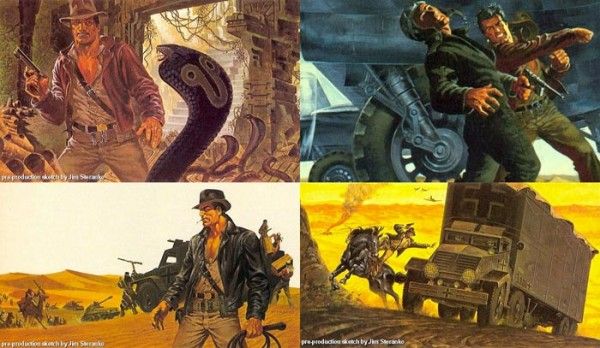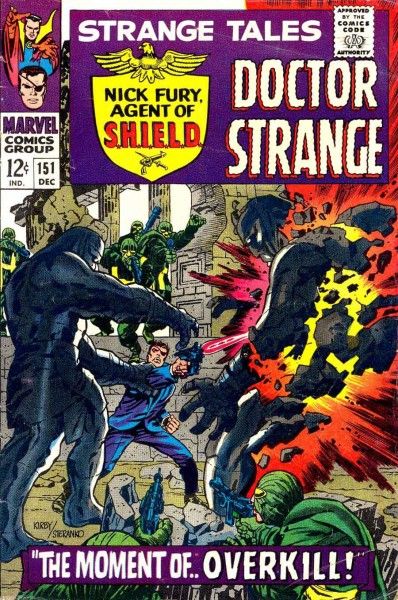Most souls outside the comics scene or Hollywood Hills might not recognize the dynamic gentleman with the epic wave of white hair, tinted shades and Dentyne-bright smile, but when jaunty Jim Steranko enters a room, they damn well know he’s somebody.
I sat down with Steranko at the 2nd annual Denver Comic-Con to mix with the master and hear him elucidate on escapology, high times at Marvel (including Nick Fury, Dr. Strange, and working with Jack “King” Kirby) health food, handing Indy his hat and biting into Coppola’s plush Dracula film adaptation. Hit the jump for the interview.
A CGC-certified comic book god, hard-boiled author and mod artist, Steranko electrified the comics world in the sweet summer of ‘66, a cool cat from Reading, Pennsylvania who breezed into Marvel’s Madison Avenue offices and was immediately whisked away to stardom, mentored by the late, great Jack Kirby.
“Well, I started at the top and worked my way down,” he kidded, signing a mint copy of Strange Tales #151, his first Marvel work.
After a short period penciling and inking over Kirby’s layouts on Strange Tales, Steranko took over the title, with covers alternating between Nick Fury and Dr. Strange. He stuck with it when Fury went solo in ’68, becoming an elemental auteur, infusing his art and writing with raw energy, elegance and sophistication.
“When I broke into comics I was an art director and design was part of my nature. No matter how I walked or talked or created, everything had to do with the aspects that formed my background, so automatically I brought that into my comic book work.
“In addition to that, I was reasonably cognizant of Op Art, Pop Art, surrealism and expressionism. I knew comics were a very forgiving form because I was a big comic reader. They could accept trends other media couldn’t reproduce quickly so I thought it was a natural thing to import artistic movements like surreal art. It was always a mystery to me that it had never been done before. You might call me 'comics’ contemporary transfusion.' ”
If Stan Lee was the rowdy ringmaster of the 1960s Marvel circus, then Jim Steranko was definitely its dashing, daring lion-tamer.
In his short experimental stay at Marvel, Steranko introduced 150 new narrative techniques to comics, further marking his territory with intoxicating issues of Captain America and X-Men. And though his lightning storm passed, the whiff of creative smoke and ozone still lingers today.
“He’s like the Robert Johnson of the comic world. They both produced the exact number of issues and recordings… twenty-nine,” explained noted author J. David Spurlock, Steranko’s longtime agent and Vanguard publishing partner.
“The sheer lack of his work out there creates an immediate demand whenever he makes an appearance.”
First and foremost, Steranko came into comics as an entertainer.
“My childhood and early twenties were spent doing stage stunts, close-up magic in area clubs and playing rock-n-roll for twelve years. I was engaged in performing since that was an interest that deeply shaped my life. I came from a cold, poor background in a matchbox house with no pictures on the walls. So I tried to fill in for what I missed from my youth. The year I came to Marvel I didn’t want to light the world on fire, I wanted to do the same thing Kirby and Severin and Wally Wood did.”
When Steranko started, Nick Fury was a recent, third-string addition to the Marvel galaxy, a generic action hero in a plain brown wrapper that might be canceled at any time.
Staring at his convention booth banner, smartly splashed with macho character art, it’s hard not to see the striking similarities between Steranko and his eye-patched super-spy.
“Nick Fury began life with a few distinguishing trademarks: a three-inch stogie, stubble on his face and a suit rumpled with a thousand wrinkles,” he said. “I transformed Fury when I took him over because I didn’t think that kind of individual could wrangle the top American security forces of S.H.I.E.L.D. So I gave Fury my own tailored suits, my mannerisms, shaved him clean like I was and then gave him my attitude — And if you don’t like me then what are you going to do about that?”
Steranko grabbed the job but knew he inherited a severe handicap.
“Fury had no mask, no costume and no superpowers. And I had to compete with Spider-Man, Fantastic Four, Thor, Batman and The Flash. I applied those transitional aspects, then thought I’d give him a tough visual persona by putting him into a skin-tight leather catsuit. In addition, I stylized that suit with belts, buckles, zippers and turned him into a sort of high-tech warrior. If he couldn’t battle in the superpowers area at least he could on visual terms.”
Marvel quickly found their fanmail bags stuffed with blushing responses from young, liberated female readers, all confessing how cool Fury was in his primal black leather.
“That was the beginning of my famous female fan base,” Steranko recalled. “It always disturbed me profoundly when my comics were printed and editors took away my female characters’ cleavage lines or blackened out the sheen and shine I put on their asses. There was no justice that I could date girls that couldn’t be shown in comic books. What a disappointment! No artwork or painting can be as beautiful as a real, live woman. I’d like to think the admiration I feel for females does show through. I believe there’s something beautiful about every woman, the way she speaks or walks or the way she smiles or the curve of her neck.”
Steranko spent his formative months beside Jack “King” Kirby, absorbing the rays while internally forging his own forceful style.
“I don’t think I was ever star-struck with anyone and I attribute that to my misspent youth. Being chained up head-to-foot, tied in a canvas bag then nailed into a wooden box and dropped to the bottom of a river. It doesn’t get more life-changing than that.
“I like to work with the best in the business and that’s resulted in collaborations with Stan Lee, Jack Kirby, Bill Everett and my fabulous inkers Frankie Giacola and Joe Sinnott, in addition to creators such as Lucas, Steven Spielberg and Francis Coppola.”
It was Steranko’s gritty drawings of Robert E. Howard’s badass adventurer, El Borak, which grabbed the young superteam of Lucas and Spielberg by the throat. Steranko was hired to design four paintings for Raiders of the Lost Ark that would become the foundation for Indiana Jones’ fedora-crowned silhouette.
With Coppola, Steranko turned to the dark side as the project conceptualist for 1992’s lush Bram Stoker’s Dracula, creating 62 storyboards and lavish visual flourishes to the project such as Dracula’s symbolist fortress and his “bat-to-rats” transformation.
“I worked on that picture for six months,” he said. “Francis had the idea in Dracula for episodes that would be suitable for 3-D. There was to be a huge masquerade ball at the Crystal Palace in Victorian London and we posited that it would be a natural for when the characters put on their masks, the audience would put their glasses on and that would happen through the movie four or five times. There was another scene aboard a train with Mina and Van Helsing where walls vanish and we enter a surreal, cloud-streaked dreamworld. There was some executive decision made that the cost of producing those sequences was prohibitive.
“In some ways comics have been an incredible education and in some areas a deep disappointment. During a reading of comics it was relatively rare that you’d have a visceral emotional response. Film did the opposite. Very early on I realized film was a much more powerful medium and, to translate that thought one step further, that the storytellers of cinema are more significantly skilled than the amateurs in comics. I’m not faulting them because most did the best they could. The truth of the matter is that there are very few Michelangelos, Einsteins and Edisons in this world.”
The man most responsible for Steranko’s neo-noir style was Michael Curtiz, famed director of Casablanca and Robin Hood.
“The film that had the strongest impact on my own storytelling sensibilities was his Mildred Pierce. This was Storytelling 101. In that, I learned more about aspects of visual narration than in any other film. Citizen Kane had a huge impact on filmmakers all over the world and it also had an impact in the comics world. I know because many of the top artists, editors and writers refer to it.”
With his notoriety marching far beyond the Marvel madhouse, Steranko’s fierce discipline kept his pure art on track to infamy.
Steranko was also a member of the infamous Witchdoctors Club, an elite social fraternity whose numbers had to be published writers, practicing magicians and have connections to The Shadow.
As a young man in his twenties at the dawn of the muscle car era, I figured Steranko as a Shelby Mustang or big-block Corvette guy.
“No, I was a motorcycle guy,” he said. “I had a BSA Golden Flash and got into a relatively bad accident with it. It was chrome and black and had been modified with a Spitfire cam and bored to forty over. It had no crash bars to fuck up the look of the bike. That’s when I got into sports cars though, both MG convertibles. My first one, used, was black with pencil-thin white racing stripes on the bonnet. The second, bought new, was white.”
They say the flame that burns twice as bright burns half as long.
But for Steranko, that fire still blazes brightly, and with rock-star status at convention appearances, book releases or exhibitions of his artwork around the planet, this septuagenarian with moxie to the max is still defining the cool he helped to create.
“Step aside Samuel L. Jackson, the real Nick Fury is here,” said Spurlock as Steranko signed a stunning Captain America poster.
“Look at him, he’s a real superhero. He can escape out of anything. Requires no sleep. Has an eye-condition that lets him see in the dark. And can put himself into suspended animation.”
Back home in Reading, Pennsylvania, Steranko can often be seen jogging the mountain behind his home with his dogs or doing a power set of biceps curls while conducting business on the phone.
He runs his life with clockwork precision, performing a regimen of rigorous exercise and a restrictive diet to put LaLanne to shame.
“I sleep two hours a night and eat one meal a day, mostly a salad and chicken,” Steranko revealed. “I also make myself protein shakes with apples and banana and cinnamon. I realized early on I didn’t need much sleep. I used to stay up late because my father didn’t like the notion of me drawing and had no interest in the visual arts. I’d wait until the family went to bed and I’d go draw on the kitchen table all night long.”
Whether or not the “Graphic Prince of Darkness” has special powers really isn’t a fair debate, judging by the long line of loving fans and loyal collectors.
“My personal philosophy demands I embrace a certain lifestyle because I know it’s going to keep me living, creating and loving more than the rest of you guys. The trick isn’t living long, but living long and well. Hey, I may live to be 125.”
Better bulk up on birthday candles. I don’t doubt him an instant.

